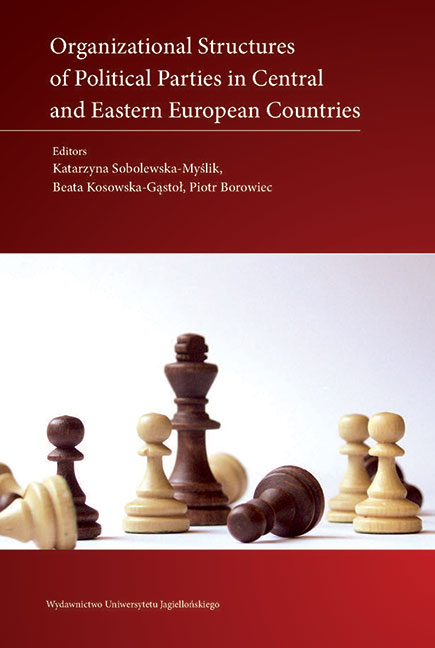Book contents
- Frontmatter
- Contents
- Preface
- Developing Party Structures in Central and Eastern Europe
- Albania: Organizations of Political Parties in Albania
- Belarus: Belarusian Political Parties: Organizational Structures and Practices
- Bosnia and Herzegovina: Organizational Structures of Political Parties in CEE Countries: A Case Study on Bosnia and Herzegovina
- Bulgaria: Organizational Structure and Trends in Bulgarian Party Politics
- Croatia: Organizational Structures of Political Parties in Croatia
- Czech Republic: Between Organizational Extremes: Czech Parties after a Political Earthquake
- Estonia: Organizational Structures of Political Parties in Estonia
- Hungary: Cut from the Same Cloth? A Comparative Analysis of Party Organizations in Hungary
- Kosovo: Structure of the Main Political Parties in Kosovo
- Latvia: Leader-Centered and Power-Hungry: Party Organizations in Latvia
- Lithuania: Organization of Political Parties: The Case of Lithuania
- Moldova: Organizational Structures of Political Parties in The Republic of Moldova
- Montenegro: Party Organization in Montenegro: Structural Resemblance Behind Political Divergence
- Poland: Structures of Polish Political Parties in the Second Decade of the 21st Century
- Romania: The Internal Organization of Romanian Political Parties
- Russia: Parties with Roots Growing Upwards: Organizational Features of Russian Political Parties
- Serbia: Organizational Structures of Political Parties in Serbia
- Slovakia: Organizational Structures of Political Parties in Slovakia: Parties not for Members
- Slovenia: Almost without Any Innovations: Organizational Structures in Slovenian Parties
- Ukraine: Shallow Party Structures in a Volatile Party System
- Comparing Organizational Structures of Political Parties in Central and Eastern European Countries
- Biographical notes about the authors
Russia: Parties with Roots Growing Upwards: Organizational Features of Russian Political Parties
- Frontmatter
- Contents
- Preface
- Developing Party Structures in Central and Eastern Europe
- Albania: Organizations of Political Parties in Albania
- Belarus: Belarusian Political Parties: Organizational Structures and Practices
- Bosnia and Herzegovina: Organizational Structures of Political Parties in CEE Countries: A Case Study on Bosnia and Herzegovina
- Bulgaria: Organizational Structure and Trends in Bulgarian Party Politics
- Croatia: Organizational Structures of Political Parties in Croatia
- Czech Republic: Between Organizational Extremes: Czech Parties after a Political Earthquake
- Estonia: Organizational Structures of Political Parties in Estonia
- Hungary: Cut from the Same Cloth? A Comparative Analysis of Party Organizations in Hungary
- Kosovo: Structure of the Main Political Parties in Kosovo
- Latvia: Leader-Centered and Power-Hungry: Party Organizations in Latvia
- Lithuania: Organization of Political Parties: The Case of Lithuania
- Moldova: Organizational Structures of Political Parties in The Republic of Moldova
- Montenegro: Party Organization in Montenegro: Structural Resemblance Behind Political Divergence
- Poland: Structures of Polish Political Parties in the Second Decade of the 21st Century
- Romania: The Internal Organization of Romanian Political Parties
- Russia: Parties with Roots Growing Upwards: Organizational Features of Russian Political Parties
- Serbia: Organizational Structures of Political Parties in Serbia
- Slovakia: Organizational Structures of Political Parties in Slovakia: Parties not for Members
- Slovenia: Almost without Any Innovations: Organizational Structures in Slovenian Parties
- Ukraine: Shallow Party Structures in a Volatile Party System
- Comparing Organizational Structures of Political Parties in Central and Eastern European Countries
- Biographical notes about the authors
Summary
Introduction
The organizational structures of Russian political parties, as well as features of other institutions, were formed under the conditions prevailing after the destruction of the Soviet one-party dictatorship. Among the most important factors is a mass disinclination of the public to participate in party activity after so many years of partocracy. This caused great problems with grassroots party structures, political fundraising, and mobilization of support during election periods. New modes of political communication have also failed to contribute to the creation of strong local organizations. The mediatization of politics, observed in the West, has acquired the form of mediacracy in Russia, where the media function as the main and almost the sole mediator between the rulers and the ruled (Mazzoleni and Shulz 1999).
At the same time, in post-Soviet Russia, as well as throughout other post-communist countries, the intent to imitate Western patterns of democratic institutions was long a dominant trend (Pshizova 2005). Meanwhile in the West, political parties were considered to be one of the most important and compulsory attributes of democracy. Therefore, Russian politicians and activists of all orientations tried to create political parties in the image and likeness of their Western counterparts – including with regard to organizational structures. The failure of these attempts has predetermined the leading role of the state in building the party system, as well as the administrative nature of Russian political parties. The party creation was carried out at the hand of political technologists, consultants and image makers, public relations specialists, etc. While Western political parties incorporated these professionals very slowly and gradually into their structures, this process was much more rapid and large-scale in Russia. Gradually, the ruling group, which has “colonized the state,” has turned political parties into an administrative instrument of power.
Degrees of Participation and Space for Manipulation
To understand the development of the party system in post-communist Russia, we should examine the relationship of party members to their parties and political environment. Duverger's famous concentric circles, illustrating degrees of participation in political parties, can be used as a tool for analysis (Figure 1).
- Type
- Chapter
- Information
- Organizational Structures of Political Parties in Central and Eastern European Countries , pp. 349 - 368Publisher: Jagiellonian University PressPrint publication year: 2017



